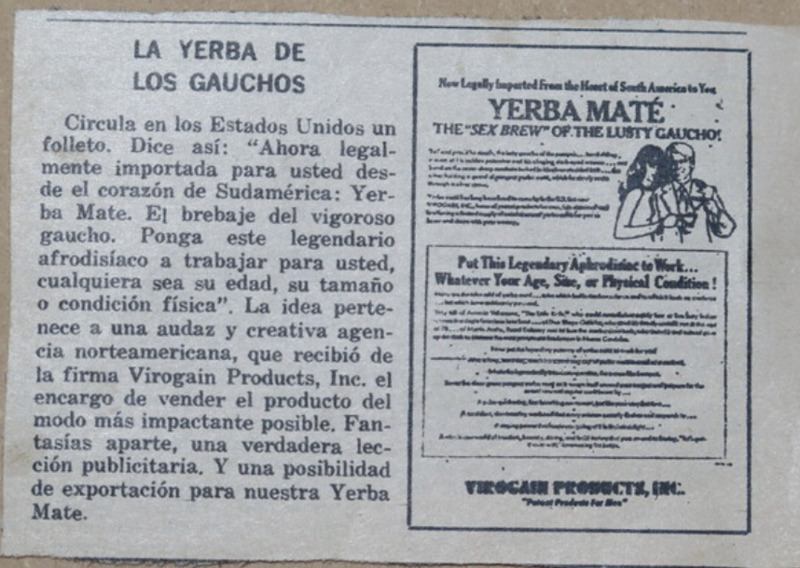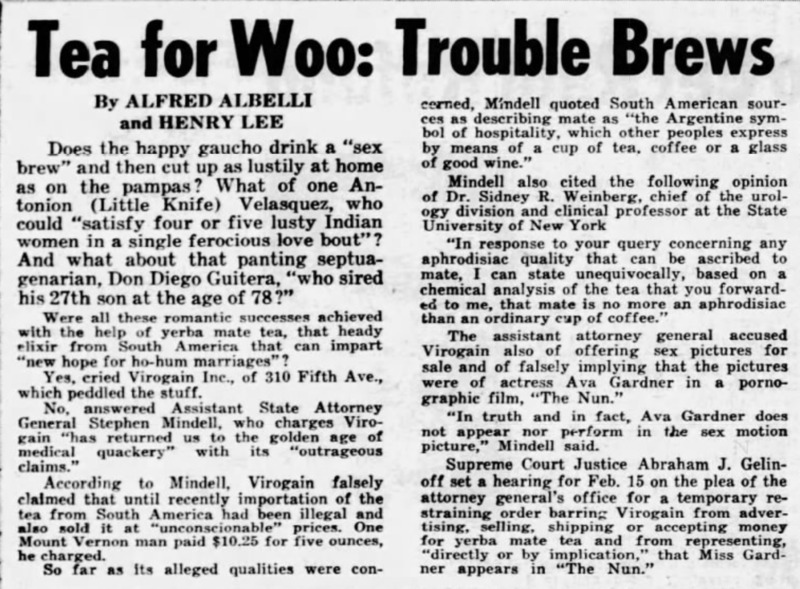Yerba Mate's First Strategy for Sales
During this time period yerba mate was just making its entrance into the United States market. These advertisements were created to help yerba stand out and also introduce it to a new market.
As seen in this advertisement from the 1960s, a tactic of initial selling of yerba mate was advertising it as an aphrodisiac. This advertisement was targeted mainly at men with the picture of the woman hanging onto the man, and the mention of the gaucho, or a South American cowboy or strong male figure in general. This is important because by focusing the audience just on men the advertisement effectively ignored half of the US market. Despite much progress being made over the prior years women were still only seen as “happy homemakers, secretaries, teachers, and nurses” (“Women in the 60's”). One of the duties usually associated with being a homemaker was shopping which would mean that the person buying the product would most likely be female. According to Nikki Nelson, writing for a professional business strategy company on advertising, “Ideally, advertising should capture the prospective customers' attention and entice them to use your product” (Nelson 2021). Since the customer of the product would probably be a female, it is more than likely that this advertisement would have been ineffective.
Not long after yerba was being sold as an aphrodisiac did articles, like this one, come out saying that it did work which depleted the potential market of buyers of this substance. In this New York Daily News article, it is mentioned that many qualified professionals do not agree with the “facts” that the yerba mate company, Virogain, was using to try and sell their product. The professionals claim that Virogain is falsely advertising their product and it even goes as far as to be taken to the Supreme Court because of these claims.
Credibility of a source is integral to its success (Rose 2016). This source proves, with very little room for doubt, that the “miracle drink” of yerba mate might not be all that it had been advertised to be. Regardless of the numerous health benefits that could have been true, the few claims that were proven false caused major caution surrounding the product.
An article in the Philadelphia Inquirer also talks about the false advertising of this product with many similar topics as the article before. This article also talks about the tests that say it's no different than a cup of coffee in the regards of being a “sex brew”. The mention of the ineffectiveness of yerba mate as the product it was being advertised to be, especially by using credible professionals to back up these statements, was disastrous for the success of yerba advertisements which continued along this path for several years to come.
As a Whole
Despite the downward spiral that these ads took, it is not hard to see that initally yerba mate was being sold as sex or love in the household. In the article "Food is Love", by Katherine Parkin, she states that "food was marketed almost exclusively to women" (Parkin) by employing six themes. One of the central themes that she focuses on is that "food is love". This appears to be the same theme they were trying to play on for these advertisments, but as it was not aimed that the female market, the ones buying the products, it was not as sucessful. Also, after the credibility was lost becasue many reliable sources said that yerba mate can not create love, this advertising strategy fell apart.



